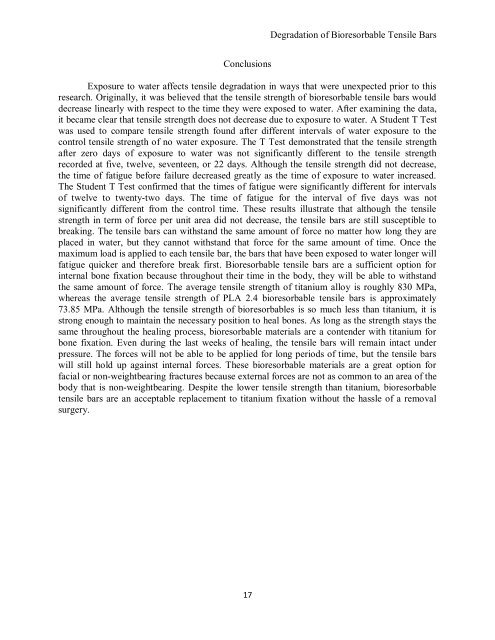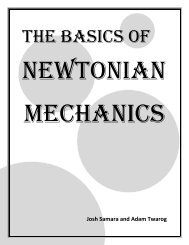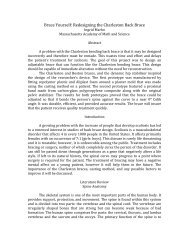A Study of Tensile Degradation of Bioresorbable Materials Used for ...
A Study of Tensile Degradation of Bioresorbable Materials Used for ...
A Study of Tensile Degradation of Bioresorbable Materials Used for ...
Create successful ePaper yourself
Turn your PDF publications into a flip-book with our unique Google optimized e-Paper software.
<strong>Degradation</strong> <strong>of</strong> <strong>Bioresorbable</strong> <strong>Tensile</strong> Bars<br />
Conclusions<br />
Exposure to water affects tensile degradation in ways that were unexpected prior to this<br />
research. Originally, it was believed that the tensile strength <strong>of</strong> bioresorbable tensile bars would<br />
decrease linearly with respect to the time they were exposed to water. After examining the data,<br />
it became clear that tensile strength does not decrease due to exposure to water. A Student T Test<br />
was used to compare tensile strength found after different intervals <strong>of</strong> water exposure to the<br />
control tensile strength <strong>of</strong> no water exposure. The T Test demonstrated that the tensile strength<br />
after zero days <strong>of</strong> exposure to water was not significantly different to the tensile strength<br />
recorded at five, twelve, seventeen, or 22 days. Although the tensile strength did not decrease,<br />
the time <strong>of</strong> fatigue be<strong>for</strong>e failure decreased greatly as the time <strong>of</strong> exposure to water increased.<br />
The Student T Test confirmed that the times <strong>of</strong> fatigue were significantly different <strong>for</strong> intervals<br />
<strong>of</strong> twelve to twenty-two days. The time <strong>of</strong> fatigue <strong>for</strong> the interval <strong>of</strong> five days was not<br />
significantly different from the control time. These results illustrate that although the tensile<br />
strength in term <strong>of</strong> <strong>for</strong>ce per unit area did not decrease, the tensile bars are still susceptible to<br />
breaking. The tensile bars can withstand the same amount <strong>of</strong> <strong>for</strong>ce no matter how long they are<br />
placed in water, but they cannot withstand that <strong>for</strong>ce <strong>for</strong> the same amount <strong>of</strong> time. Once the<br />
maximum load is applied to each tensile bar, the bars that have been exposed to water longer will<br />
fatigue quicker and there<strong>for</strong>e break first. <strong>Bioresorbable</strong> tensile bars are a sufficient option <strong>for</strong><br />
internal bone fixation because throughout their time in the body, they will be able to withstand<br />
the same amount <strong>of</strong> <strong>for</strong>ce. The average tensile strength <strong>of</strong> titanium alloy is roughly 830 MPa,<br />
whereas the average tensile strength <strong>of</strong> PLA 2.4 bioresorbable tensile bars is approximately<br />
73.85 MPa. Although the tensile strength <strong>of</strong> bioresorbables is so much less than titanium, it is<br />
strong enough to maintain the necessary position to heal bones. As long as the strength stays the<br />
same throughout the healing process, bioresorbable materials are a contender with titanium <strong>for</strong><br />
bone fixation. Even during the last weeks <strong>of</strong> healing, the tensile bars will remain intact under<br />
pressure. The <strong>for</strong>ces will not be able to be applied <strong>for</strong> long periods <strong>of</strong> time, but the tensile bars<br />
will still hold up against internal <strong>for</strong>ces. These bioresorbable materials are a great option <strong>for</strong><br />
facial or non-weightbearing fractures because external <strong>for</strong>ces are not as common to an area <strong>of</strong> the<br />
body that is non-weightbearing. Despite the lower tensile strength than titanium, bioresorbable<br />
tensile bars are an acceptable replacement to titanium fixation without the hassle <strong>of</strong> a removal<br />
surgery.<br />
17
















